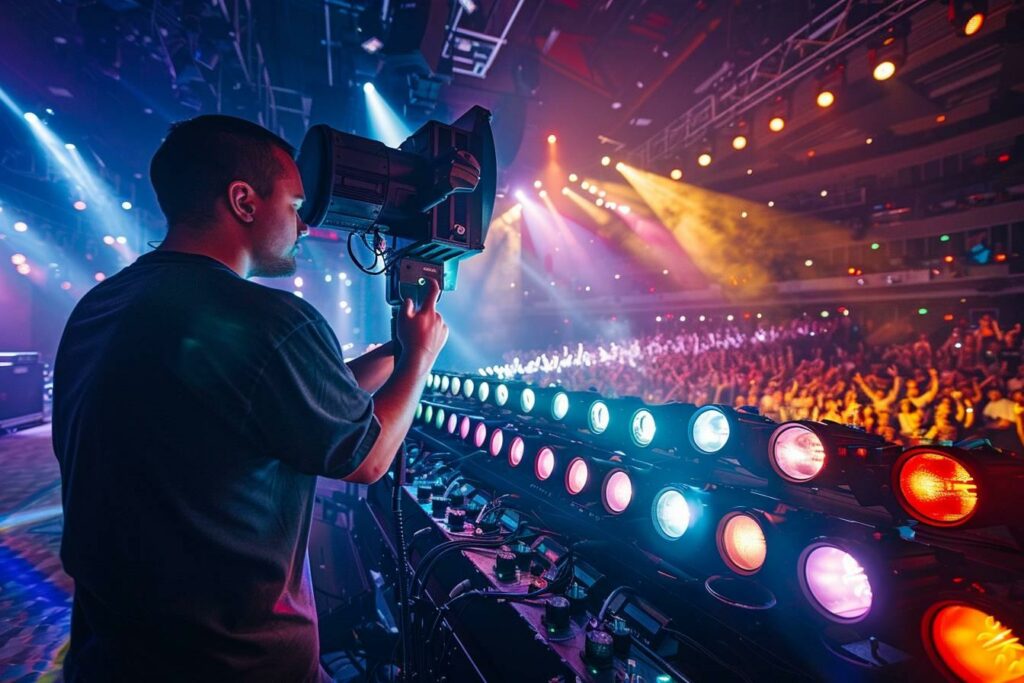Stage lighting plays an essential role in creating a captivating atmosphere during a show. Whether it’s a concert, a play or a special event, lighting can transform an ordinary performance into an unforgettable experience. In this text, we explore the different types of stage lights, their applications and how to use them to enhance your productions.
Essential types of stage lighting
Stage lighting includes a variety of lighting tools, each with its own specific function. Here are the main types of stage lights you should know about:
- PAR spotlights
- Servo headlamps
- Cut-out spotlights
- Blinders
- Stroboscopes
- LED bars
PAR spotlights are versatile and widely used to create diffused light. Strobe lights, meanwhile, offer unrivalled flexibility with their programmable movements. For precise lighting, cut-out projectors are indispensable, enabling light to be sculpted with gobos and irises.
Blinders create a powerful visual impact by illuminating the audience, while strobes add energy with their rapid flashes. Finally, LED bars have become indispensable for their versatility and energy efficiency.
Choosing the right combination of these lights can transform your stage into an extraordinary visual journey, creating an atmosphere that will remain etched in the audience’s memory.
Lighting techniques to enhance your show
Mastering the art of stage lighting requires a thorough understanding of the fundamental principles and techniques involved. Here are a few ways to optimize the use of your stage lights:
- Layering: superimpose different light sources
- Color mixing: mix colors to create unique atmospheres
- Focusing: direct light precisely to highlight key elements
- Dimming: modulate light intensity to create dynamism
Layering involves combining several light sources to add depth to your scene. For example, use PAR spotlights for basic lighting, then add lyres for dynamic effects and cut-out spotlights for precise accents.
Color mixing is necessary to set the mood. Modern LEDs allow you to create an infinite palette of colors. Experiment with warm and cool combinations to evoke different emotions. Cool blue lighting can suggest mystery, while warm orange evokes comfort.
Focusing is the art of directing light with precision. Use cut-out spotlights to isolate a performer or highlight a set element. This technique is particularly effective for guiding the audience’s attention and creating intimate moments on stage.
Finally, dimming allows you to control light intensity. A subtle play on lighting levels can dramatize a scene or create a smooth transition between different moments in the show.

Technological innovations in stage lighting
Technological evolution has revolutionized the world of stage lighting. Recent innovations offer lighting designers more powerful and flexible tools than ever before. Here’s an overview of some of the most significant advances:
| Technology | Benefits | Applications |
|---|---|---|
| Intelligent LEDs | Energy-saving, precise color control | Ambient lighting, complex visual effects |
| Wireless DMX control | Flexible installation, cable reduction | Ephemeral events, historical sites |
| Projection mapping | Immersive environments | Dynamic backdrops, special effects |
| AI-assisted lighting | Automated programming, increased reactivity | Interactive shows, real-time optimization |
Smart LEDs have transformed the industry, offering unprecedented energy efficiency and precise color control. They enable the creation of complex visual effects while reducing power consumption and heat generation.
Wireless DMX control has freed designers from the constraints of wiring. This technology facilitates installation in difficult-to-access locations or for temporary events, offering greater flexibility in lighting design.
Projection mapping has opened up new creative possibilities. This technique enables images and animations to be projected onto three-dimensional surfaces, transforming any object or building into a dynamic screen. It is particularly popular for open-air shows and art installations.
Artificial intelligence-assisted lighting represents the future of the industry. These systems can analyze music in real time and automatically adjust lighting, creating synchronized, responsive shows without constant human intervention.
Creating an unforgettable atmosphere with lighting
The art of creating a memorable atmosphere with stage lighting lies in understanding the psychology of color and mastering the rhythm of light. Here’s how to exploit the full potential of your lighting:
Color psychology plays a crucial role in setting the mood. Red evokes passion and energy, ideal for the intense moments of a rock concert. Blue can create a serene atmosphere, perfect for an intimate acoustic solo. Green is associated with nature and can be used for outdoor scenes or environmental themes.
Light rhythm is just as important as color. Fast, dynamic changes can amplify the excitement of an energetic performance, while soft, slow transitions can accompany more contemplative moments. Synchronizing lighting changes with music or action on stage creates a symbiosis that captivates the audience.
To create a truly unique ambience, consider these advanced techniques:
- Use gobos to project patterns and textures
- Creating dramatic silhouettes with backlighting
- Use of fog or smoke to give volume to the light
- Integrating LED elements into costumes or sets
Lighting can also be used to subtly guide the audience’s attention. A well-placed spotlight can highlight a soloist, while an overall change in lighting mood can signal a transition in the story or performance.
Don’t forget that subtlety can be just as powerful as spectacular effects. A simple fade to black at the right moment can create a striking visual silence, leaving the audience in suspense before the next act.
Ultimately, the key to creating an unforgettable atmosphere lies in the ability to tell a story through light. Every lighting choice should serve the overall narrative of your show, whether it’s a concert, a play or a special event. By mastering these techniques and combining them creatively, you’ll transform your stage into a magical space that will remain etched in your audience’s memory long after the spotlights have faded.

